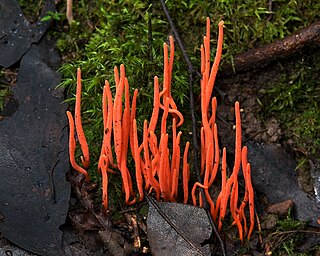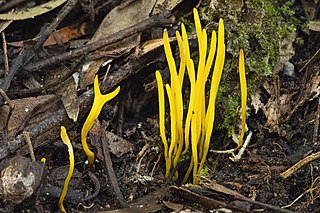
The Clavariaceae are a family of fungi in the order Agaricales. Originally the family contained most of the clavarioid fungi, but in its current sense is more restricted, albeit with a greater diversity of basidiocarp forms. Basidiocarps are variously clavarioid or agaricoid (mushroom-shaped), less commonly corticioid or hydnoid.

The Physalacriaceae are a family of fungi in the order Agaricales. Species in the family have a widespread distribution, ranging from the Arctic, (Rhizomarasmius), to the tropics, e.g. Gloiocephala, and from marine sites (Mycaureola) and fresh waters (Gloiocephala) to semiarid forests (Xerula).

Ramariopsis is a genus of coral fungi in the family Clavariaceae. The genus has a collectively widespread distribution and contains about 40 species. The name means 'having the appearance of Ramaria'.

Ramariopsis kunzei is an edible species of coral fungi in the family Clavariaceae, and the type species of the genus Ramariopsis. It is commonly known as white coral because of the branched structure of the fruit bodies that resemble marine coral. The fruit bodies are up to 5 cm (2.0 in) tall by 4 cm (1.6 in) wide, with numerous branches originating from a short rudimentary stem. The branches are one to two millimeters thick, smooth, and white, sometimes with yellowish tips in age. Ramariopsis kunzei has a widespread distribution, and is found in North America, Europe, Asia, and Australia.

Clavaria is a genus of fungi in the family Clavariaceae. Species of Clavaria produce basidiocarps that are either cylindrical to club-shaped or branched and coral-like. They are often grouped with similar-looking species from other genera, when they are collectively known as the clavarioid fungi. All Clavaria species are terrestrial and most are believed to be saprotrophic. In Europe, they are typical of old, mossy, unimproved grassland. In North America and elsewhere, they are more commonly found in woodlands.

The clavarioid fungi are a group of fungi in the Basidiomycota typically having erect, simple or branched basidiocarps that are formed on the ground, on decaying vegetation, or on dead wood. They are colloquially called club fungi and coral fungi.

Clavaria fragilis, commonly known as fairy fingers, white worm coral, or white spindles, is a species of fungus in the family Clavariaceae. It is synonymous with Clavaria vermicularis. The fungus is the type species of the genus Clavaria and is a typical member of the clavarioid or club fungi. It produces tubular, unbranched, white basidiocarps that typically grow in clusters. The fruit bodies can reach dimensions of 15 cm (5.9 in) tall by 0.5 cm (0.2 in) thick. Clavaria fragilis is a saprobic species, growing in woodland litter or in old, unimproved grassland. It is widespread throughout temperate regions in the Northern Hemisphere, but has also been reported from Australia and South Africa. The fungus is edible, but insubstantial and flavorless. There are several other small white coral-like fungi with which C. fragilis may be confused.

Clavaria zollingeri, commonly known as the violet coral or the magenta coral, is a widely distributed species of fungus. It produces striking tubular, purple to pinkish-violet fruit bodies that grow up to 10 cm (3.9 in) tall and 7 cm (2.8 in) wide. The extreme tips of the fragile, slender branches are usually rounded and brownish. A typical member of the clavarioid or club fungi, Clavaria zollingeri is saprobic, and so derives nutrients by breaking down organic matter. The fruit bodies are typically found growing on the ground in woodland litter, or in grasslands. Variations in branching and color can often be used to distinguish C. zollingeri from similarly colored coral fungi such as Alloclavaria purpurea and Clavulina amethystina, although microscopy is required to reliably identify the latter species.

Clavariadelphus ligula, commonly known as the strap coral, is a species of fungus in the family Gomphaceae. It produces club-shaped fruit bodies with spongy flesh that grow in groups on the forest floor. It is found in Asia, Europe, and North America.

Multiclavula is a genus of basidiolichens in the family Hydnaceae. The widespread genus contains 14 species. The genus was circumscribed by the American mycologist Ron Petersen in 1967, with Multiclavula corynoides assigned as the type species.

Clavulinopsis amoena is a clavarioid fungus in the family Clavariaceae. It forms slender, cylindrical, golden-yellow fruiting bodies that grow on the ground among plant litter. It was originally described from Indonesia and appears to be distributed in temperate areas of the southern hemisphere.
Clavulina puiggarii is a species of coral fungus in the family Clavulinaceae. It is found in Australia and Brazil.

Clavulinopsis umbrinella, commonly known as the beige coral, is a coral mushroom in the family Clavariaceae. Fruit bodies are initially white before turning pale brown with darker brown tips. Originally described in 1860, it is known to occur in Europe and North America where it grows in grass. It is not a common species.

Clavulinopsis helvola is a clavarioid fungus in the family Clavariaceae. In the UK, it has the recommended English name of yellow club. It forms slender, cylindrical, yellow fruiting bodies that grow on the ground in agriculturally unimproved grassland or in woodland litter. It was originally described from Europe.

Clavulinopsis fusiformis is a clavarioid fungus in the family Clavariaceae. In the UK, it has been given the recommended English name of golden spindles. In North America it has also been called spindle-shaped yellow coral or golden fairy spindle. Clavulinopsis fusiformis forms cylindrical, bright yellow fruit bodies that grow in dense clusters on the ground in agriculturally unimproved grassland or in woodland litter. It was originally described from England and is part of a species complex as yet unresolved.

Clavulinopsis laeticolor, commonly known as the golden fairy club or handsome club, is a clavarioid fungus in the family Clavariaceae. It forms slender, cylindrical, yellow fruit bodies that grow on the ground in woodland litter or in agriculturally unimproved grassland. It was originally described from Cuba and is part of a species complex as yet unresolved.

Hirticlavula is a fungal genus in the family Clavariaceae. It contains a single described species, Hirticlavula elegans. Formally described in 2014, the fungus has been collected from Norway and Denmark. H. elegans produces white fruit bodies up to 1.1 millimetres (0.043 in) in height. Each fruit body contains a fertile head atop a hairy stem. The fruit bodies grow directly from dead bark or wood, where they feed as saprotrophs. Both morphological and ecological details are distinctive when compared to other clavarioid fungi.

Clavulinopsis corniculata is a clavarioid fungus in the family Clavariaceae. In the UK, it has the recommended English name of meadow coral. It forms branched, cylindrical, ochre fruit bodies that grow on the ground in agriculturally unimproved grassland or in woodland litter. It was originally described from Germany and is part of a species complex as yet unresolved.

Clavulinopsis aurantiocinnabarina is a clavarioid fungus in the family Clavariaceae. It has been given the English names of orange spindle coral or orange worm coral. It forms cylindrical, orange fruit bodies that grow on the ground in woodland litter. It was originally described from the United States and is part of a species complex as yet unresolved.

Multiclavula mucida is a globally distributed species of basidiolichen belonging to the family Hydnaceae. Since its initial classification by Christiaan Hendrik Persoon in 1797, the species has been described under various synonyms and associated with multiple genera. Persoon described its fruiting bodies as gregarious, varying from simple to branching structures, predominantly whitish in colour with yellow to brownish tips. He also noted its frequent appearance in autumn on decaying, moist wood, often covered with a greenish crust necessary for its growth.















